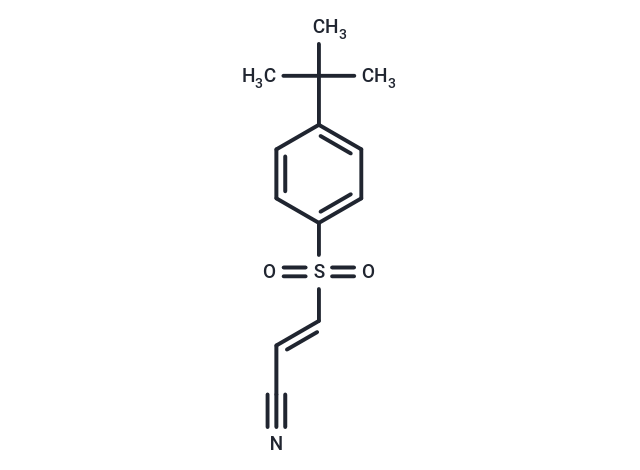Shopping Cart
Remove All Your shopping cart is currently empty
Your shopping cart is currently empty
Bay 11-7085 can irreversibly inhibit the IκBα phosphorylation induced by TNFα (IC50: 10 μM).

| Pack Size | Price | USA Warehouse | Global Warehouse | Quantity |
|---|---|---|---|---|
| 2 mg | $30 | In Stock | In Stock | |
| 5 mg | $43 | In Stock | In Stock | |
| 10 mg | $61 | In Stock | In Stock | |
| 25 mg | $77 | In Stock | In Stock | |
| 50 mg | $126 | In Stock | In Stock | |
| 100 mg | $207 | In Stock | In Stock | |
| 200 mg | $269 | In Stock | In Stock | |
| 1 mL x 10 mM (in DMSO) | $56 | In Stock | In Stock |
| Description | Bay 11-7085 can irreversibly inhibit the IκBα phosphorylation induced by TNFα (IC50: 10 μM). |
| Targets&IC50 | IκBα phosphorylation:10 μM |
| In vitro | In athymic nude mice harboring Caov-3 cells, BAY 11-7085 enhances the inhibitory effect of paclitaxel on intraperitoneal spread and ascites formation. Additionally, BAY 11-7085 suppresses the increase in NF-κB activity associated with meningitis, improves the clinical condition of infected rats, and significantly reduces CNS complications and inflammation related to meningitis. |
| In vivo | When used in conjunction with paclitaxel, BAY 11-7085 enhances the inhibition of NF-κB activity and reduces the survival rate of paclitaxel-treated cells. By inhibiting NF-κB, BAY 11-7085 suppresses the expression of the adhesion molecules E-selectin, ICAM-1, and VCAM-1 induced by TNFα. BAY 11-7085 (10 μM) exhibits no cytotoxicity towards HUVEC cells. Moreover, the combined use of BAY 11-7085 and LY294002 synergistically influences apoptosis in PEL cells. |
| Kinase Assay | In Gel Kinase Assay: In gel kinase assay for the proteins that phosphorylate IκB-α is carried out as detailed below. Whole cell extracts are prepared from HUVEC treated with TNFα (100 units/ml) for 15 min in the presence or absence of inhibitor (20 μM, pretreatment for 1 h) as indicated. Proteins are separated on a 10% SDS gel containing 0.5 mg/ml HIS-IκB-α. Gels are washed two times in 20% propanol, 50 mM Hepes, pH 7.6, for 30 min and two times in buffer A (50 mM Hepes, pH 7.6, 5 mM 2-mercaptoethanol) for 30 min, followed by a 1-h incubation with buffer A containing 6 M urea, 1 h each in 3, 1.5, and 0.75 M urea in buffer A and 0.05% Tween 20 and 1 h in buffer A with 0.05% Tween 20. The kinase assay is carried out for 1 h at 30?°C in the presence of 50 μM ATP, 5 μCi/ml [32P]ATP, 20 mM Hepes, pH 7.6, 20 mM MgCl2, 20 mM β-glycerophosphate, 20 mM p-nitrophenyl phosphate, 1 mM sodium vanadate, 2 mM dithiothreitol. The gel is washed with 5% trichloroacetic acid and 1% sodium pyrophosphate, dried, and exposed to film. A separate gel with no HIS-IκB-α is assayed as a control. |
| Cell Research | Human umbilical vein endothelial cells (HUVEC) are isolated and maintained in culture. Cell toxicity is assessed by morphology and by MTT assay.(Only for Reference) |
| Synonyms | BAY 11-7083 |
| Molecular Weight | 249.33 |
| Formula | C13H15NO2S |
| Cas No. | 196309-76-9 |
| Smiles | CC(C)(C)c1ccc(cc1)S(=O)(=O)\C=C\C#N |
| Relative Density. | 1.144g/cm3 |
| Color | White |
| Appearance | Solid |
| Storage | keep away from direct sunlight,keep away from moisture,store at low temperature | Powder: -20°C for 3 years | In solvent: -80°C for 1 year | Shipping with blue ice/Shipping at ambient temperature. | ||||||||||||||||||||||||||||||||||||||||
| Solubility Information | DMSO: 125 mg/mL (501.34 mM), Sonication is recommended. Ethanol: 24.9 mg/mL (99.87 mM), Sonication is recommended. | ||||||||||||||||||||||||||||||||||||||||
| In Vivo Formulation | 10% DMSO+40% PEG300+5% Tween 80+45% Saline: 2 mg/mL (8.02 mM), Sonication is recommended. Please add the solvents sequentially, clarifying the solution as much as possible before adding the next one. Dissolve by heating and/or sonication if necessary. Working solution is recommended to be prepared and used immediately. The formulation provided above is for reference purposes only. In vivo formulations may vary and should be modified based on specific experimental conditions. | ||||||||||||||||||||||||||||||||||||||||
Solution Preparation Table | |||||||||||||||||||||||||||||||||||||||||
Ethanol/DMSO
DMSO
| |||||||||||||||||||||||||||||||||||||||||
| Size | Quantity | Unit Price | Amount | Operation |
|---|

Copyright © 2015-2025 TargetMol Chemicals Inc. All Rights Reserved.